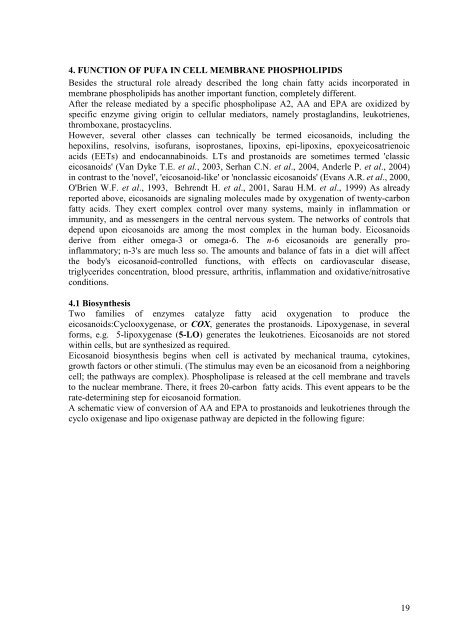Oil for Life to Balance omega-3 polyunsaturated fatty acids ... - Oil4Life
Oil for Life to Balance omega-3 polyunsaturated fatty acids ... - Oil4Life
Oil for Life to Balance omega-3 polyunsaturated fatty acids ... - Oil4Life
You also want an ePaper? Increase the reach of your titles
YUMPU automatically turns print PDFs into web optimized ePapers that Google loves.
4. FUNCTION OF PUFA IN CELL MEMBRANE PHOSPHOLIPIDS<br />
Besides the structural role already described the long chain <strong>fatty</strong> <strong>acids</strong> incorporated in<br />
membrane phospholipids has another important function, completely different.<br />
After the release mediated by a specific phospholipase A2, AA and EPA are oxidized by<br />
specific enzyme giving origin <strong>to</strong> cellular media<strong>to</strong>rs, namely prostaglandins, leukotrienes,<br />
thromboxane, prostacyclins.<br />
However, several other classes can technically be termed eicosanoids, including the<br />
hepoxilins, resolvins, isofurans, isoprostanes, lipoxins, epi-lipoxins, epoxyeicosatrienoic<br />
<strong>acids</strong> (EETs) and endocannabinoids. LTs and prostanoids are sometimes termed 'classic<br />
eicosanoids' (Van Dyke T.E. et al., 2003, Serhan C.N. et al., 2004, Anderle P. et al., 2004)<br />
in contrast <strong>to</strong> the 'novel', 'eicosanoid-like' or 'nonclassic eicosanoids' (Evans A.R. et al., 2000,<br />
O'Brien W.F. et al., 1993, Behrendt H. et al., 2001, Sarau H.M. et al., 1999) As already<br />
reported above, eicosanoids are signaling molecules made by oxygenation of twenty-carbon<br />
<strong>fatty</strong> <strong>acids</strong>. They exert complex control over many systems, mainly in inflammation or<br />
immunity, and as messengers in the central nervous system. The networks of controls that<br />
depend upon eicosanoids are among the most complex in the human body. Eicosanoids<br />
derive from either <strong>omega</strong>-3 or <strong>omega</strong>-6. The n-6 eicosanoids are generally proinflamma<strong>to</strong>ry;<br />
n-3's are much less so. The amounts and balance of fats in a diet will affect<br />
the body's eicosanoid-controlled functions, with effects on cardiovascular disease,<br />
triglycerides concentration, blood pressure, arthritis, inflammation and oxidative/nitrosative<br />
conditions.<br />
4.1 Biosynthesis<br />
Two families of enzymes catalyze <strong>fatty</strong> acid oxygenation <strong>to</strong> produce the<br />
eicosanoids:Cyclooxygenase, or COX, generates the prostanoids. Lipoxygenase, in several<br />
<strong>for</strong>ms, e.g. 5-lipoxygenase (5-LO) generates the leukotrienes. Eicosanoids are not s<strong>to</strong>red<br />
within cells, but are synthesized as required.<br />
Eicosanoid biosynthesis begins when cell is activated by mechanical trauma, cy<strong>to</strong>kines,<br />
growth fac<strong>to</strong>rs or other stimuli. (The stimulus may even be an eicosanoid from a neighboring<br />
cell; the pathways are complex). Phospholipase is released at the cell membrane and travels<br />
<strong>to</strong> the nuclear membrane. There, it frees 20-carbon <strong>fatty</strong> <strong>acids</strong>. This event appears <strong>to</strong> be the<br />
rate-determining step <strong>for</strong> eicosanoid <strong>for</strong>mation.<br />
A schematic view of conversion of AA and EPA <strong>to</strong> prostanoids and leukotrienes through the<br />
cyclo oxigenase and lipo oxigenase pathway are depicted in the following figure:<br />
19


